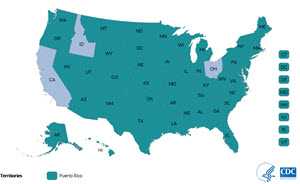What is PRAMS?
PRAMS, the Pregnancy Risk Assessment Monitoring System, is a surveillance project of the Centers for Disease Control and Prevention (CDC) and state health departments. Developed in 1987, PRAMS collects state-specific, population-based data on maternal attitudes and experiences before, during, and shortly after pregnancy. PRAMS surveillance currently covers about 83% of all U.S. births.
PRAMS provides data not available from other sources. These data can be used to identify groups of women and infants at high risk for health problems, to monitor changes in health status, and to measure progress towards goals in improving the health of mothers and infants. PRAMS data are used by researchers to investigate emerging issues in the field of reproductive health and by state and local governments to plan and review programs and policies aimed at reducing health problems among mothers and babies.
Highlighted Publications
Nicotine Replacement Therapy and Other Interventions for Pregnant Smokers: Pregnancy Risk Assessment Monitoring System, 2009-2010. Kapaya M, Tong V, Ding H. Prev Med. 2015 Sept;78: 92-100. DOI: 10.1016/j.ypmed.2015.07.008
Patterns of Health Insurance Coverage Around the Time of Pregnancy Among Women with Live-Born Infants — Pregnancy Risk Assessment Monitoring System, 29 States, 2009. D’Angelo DV, Le B, O’Neil ME, et al. MMWR Surveill Summ 2015;64(No. SS-4)
Influenza Vaccination Coverage Among Pregnant Women — United States, 2014–15 Influenza Season. Helen Ding, MD, Carla L. Black, PhD, Sarah Ball, ScD, et al. MMWR Morb Mortal Wkly Rep 2015;64:1000-5
Provider communication on perinatal depression: a population-based study. Farr SL, Ko JY, Burley K, Gupta S. Arch Womens Ment Health. 2015 Jan 13. PMID:25578631
Get Email Updates
To receive email updates about this page, enter your email address:
Related CDC Web Sites
Social Media Tools
![]() Take advantage of CDC social media tools. A number of social media tools from PRAMS are available. These free, easy-to-use communication tools can expand the reach of your health messages.
Take advantage of CDC social media tools. A number of social media tools from PRAMS are available. These free, easy-to-use communication tools can expand the reach of your health messages.
- Page last reviewed: August 30, 2017
- Page last updated: August 30, 2017
- Content source:


 ShareCompartir
ShareCompartir





